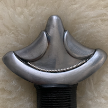-
Posts
279 -
Joined
-
Last visited
-
Days Won
2
Content Type
Profiles
Forums
Events
Store
Downloads
Gallery
Everything posted by xiayang
-

Translation Help Request for Blade in Kai Gunto Koshirae
xiayang replied to waljamada's topic in Translation Assistance
Hi Adam, the mei reads: 尾州住真野国泰鍛造之 = Mano Kuniyasu, resident of Bishū forged this 堀場好明佩帯之 = Horiba Yoshiaki owns this (literally: wears this on his belt).- 1 reply
-
- 6
-

-

-

Translation assistance on MEI/ smith and approximate dating
xiayang replied to Eds's topic in Translation Assistance
濃州住土岐亮信作 = Nōshū-jū Toki Sukenobu saku You can refer to @mecox's document for more information on the smith: -
永田祐則 = Nagata Sukenori
-

Please help with two kanji from Tanobe Sensei sayagaki
xiayang replied to a topic in Translation Assistance
Indeed, the first character is Tanobe san's way of writing 半 (half). The second character is 所. -
Yes indeed, that's it! 通政司 (Tongzhengsi) was a sort of liaison office between the emperor and various ministries in the Ming and Qing dynasties that dealt with things such as payrolls and proofreading. So it's not actually a personal seal as I first thought, but rather the seal of office of the "Tongzhengsi right councillor". I can't say whether it's a genuine antique item or a later reproduction though, that's not my area of expertise I'm afraid.
-
I don't think that is quite correct. The seal script variants of those characters or the ones in your image don't look like the characters on the seal at all (and you've even got a Hangul syllable in there too). Check for yourself on shufazidian.com (and select "篆刻"). Also, I'm fairly certain your image is upside down. Did you use OCR for this? Moriyama san's image has the correct orientation. The calligraphy is not the prettiest, but I believe I've managed to identify six out of the eight characters: ? ? 司右参議朱記 The first two characters are very likely a personal name, 司右 is a court official's title (literally translates to something like "right manager"), 参議 can be translated to "councillor" and 朱記 is "red seal".
-

Help with mei on a sword I picked today
xiayang replied to samurai1's topic in Translation Assistance
播磨守 = Harima no Kami Unfortunately, the rest of the signature is cut off. -
Jean is right, it's Kanemasa. A few more details: 濃州住栗木兼正謹作 = carefully made by Kuriki Kanemasa, resident of Nōshū
-
Looks like 芝山 = Shibayama
-

Help Identifying my Dad's Japanese Sword
xiayang replied to Michael Adamson's topic in General Nihonto Related Discussion
Hi Michael, Your blade has a Seki (関) stamp and is signed 石原兼直作 = made by Ishihara Kanenao. -

Please can someone help with a tang translation
xiayang replied to James1967's topic in Translation Assistance
Hi James, Your sword is inscribed 昭和十六年 = Shōwa 16 (1941 CE) 兼宗 = Kanemune. Markus Sesko's Swordsmiths of Japan has two entries for Shōwa era Kanemune: Fukumoto (福本) and Kiribuchi (桐淵). Yours was probably made by the former (see, e.g., here for another example). -

Help Translating and thus Identifying this Swordsmith
xiayang replied to SethKaos's topic in Translation Assistance
Here's another hint: 特殊鋼以井戸秀俊作 = made with special steel by Ido Hidetoshi -
Perhaps Iga no Kami Minamoto Kanemichi (伊賀守源包道)? The signature on yours looks very similar to this example (and the yasurime seem to match as well).
-

Translation assistance on Katana Type 98. Unusual Hamon
xiayang replied to Eds's topic in Translation Assistance
Something feels slightly off about this... 藤原信友 = Fujiwara Nobutomo 南[蠻?][鐵?]金澤[?] = Nanban tetsu Kanazawa [?] -
Hi Parker, Your blade is signed 近江守藤原綱廣 = Ōmi no Kami Fujiwara Tsunahiro. I don't suppose there is anything on the other side of the nakago (tang)?
-
When the sword went up for auction I noticed this too and it amused me enough to check what's behind it. It turns out the funny translation came about because they mixed up homophones and used a wrong character in the original Japanese listing (https://sword-auction.com/ja/product/15844/as22567-刀:靖吉(保存刀剣)/). 左官 = plasterer 佐官 = field officer Both words are pronounced the same (sakan).
-
濃州関住二十三代藤原兼房作之 = Nōshū Seki-jū nijūsan-dai Fujiwara Kanefusa saku kore (Kanefusa the 23rd, resident of Seki in Nōshū province, made this) Mal's file has more information about this smith:
-

Need help authenticating whether this blade is of value.
xiayang replied to VoidedAbyss's topic in Nihonto
It's a WW2 blade. 濃州住土岐亮信作 = Nōshū-jū Toki Akinobu saku (made by Toki Akinobu from Nōshū province) -

Translation assistance on Type 98 acquisition and approx date
xiayang replied to Eds's topic in Translation Assistance
濃州関住二十三代藤原兼房作之 = Nōshū Seki-jū nijūsan-dai Fujiwara Kanefusa saku kore The stamp is a Seki (関) stamp. -
Hi Mark, Here's a transcript: 天和貳年三月上旬 貳胴落甲切断
-
The mei is 藤原住友久 = Fujiwara-jū Tomohisa
-

Translation assistance Type 98 and approx date
xiayang replied to Eds's topic in Translation Assistance
昭和十九年十二月 = December of Shōwa 19 (1944 CE) 兼正 = Kanemasa -

Translation assistance Type 98 and approx date-has inspection stamp
xiayang replied to Eds's topic in Translation Assistance
濃州関住服部正廣作 = Nōshū Seki jū Hattori Masahiro saku -
義治 = Yoshiharu 昭和甲申春 = Shōwa, spring of the year of the wood monkey (1944 CE)



